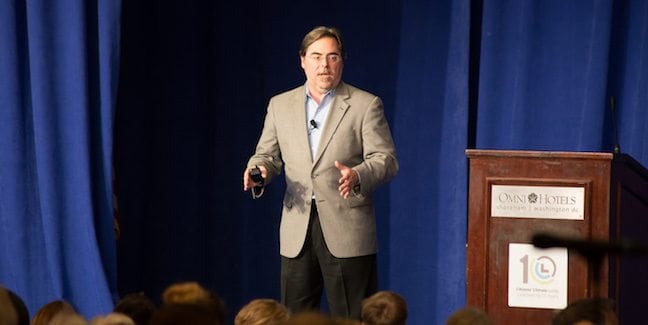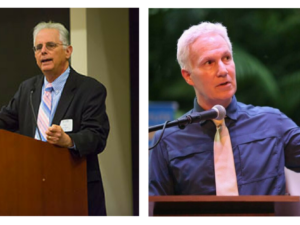
Brad Fitch, deputy director of the Congressional Management Foundation, shares his advice for effective communication with Congress.
10 tips for meeting with Congress
By Flannery Winchester
In just two more weeks, the House of Representatives will break for its August recess. All across the country, CCL volunteers will take advantage of that time by setting lobby meetings with their members of Congress in their home districts.
Brad Fitch knows a thing or two about meeting with Congress. He’s the deputy director of the Congressional Management Foundation, an organization whose mission is to build trust and effectiveness in Congress. In practice, that means the CMF team consults with members of Congress, offers confidential guidance, conducts staff training programs, all to help Congress work better. They also gather first-hand information through surveys, focus groups and interviews with congressional staff so they can understand the best ways to communicate with these lawmakers and their offices.
And communicating with Congress is crucial for it to function well. Despite what many people think, members of Congress really do place high value on their constituents’ opinions. In 2011, CMF did a rare survey of the actual members of the House of Representatives. They asked each member to rate the importance of various job aspects for their effectiveness as a representative. The number one answer? “Staying in touch with constituents,” which 95% of the representatives rated as most important. So they are listening.
And since they’re listening, we have to be ready to talk. Fitch spoke at our 2017 conference to give us a few key points about effective lobbying:
- Be clear on your goal. Fitch advised going in with a specific metric or something you want to achieve. “You’d be shocked at the number of groups who don’t,” he said. “They just come in and say, ‘Hey, I just want you to support the issue.’” He gave the example of the Women’s March in January, which was by all accounts a wildly successful event. But for the follow-up, some national groups encouraged marchers to “send a message to Congress to support women.” That’s too vague to be effective, so make sure your request or message for Congress is clear.
- Know who you’re talking to. “Do a little research tonight on the lawmaker. It’s really easy!” Fitch encouraged. “Even if you’re just looking at their website,” he said, that’s a great place to start. You never know when you might have an alma mater, a hobby, or perhaps a hometown connection in common.
- Know your issue. “Yes, under the Constitution you can petition your government for redress of grievances,” Fitch joked, “but you also have the right to know what you’re talking about.” You don’t have to be an expert, but have your talking points prepared so you can have an effective conversation.
- Connect the issue to the member’s district or state. This is easy to do when it comes to climate change, since the effects are varied and already widespread. “If you live in a coastal area, or if you live in an area that’s been experiencing unusual weather patterns, this is a connection to the district or state,” Fitch said.
- Keep it short. “Most meetings on capitol hill last 15 minutes but can be cut short because of votes, interruptions, phone calls, unexpected guests,” Fitch explained. So you should be prepared to…
- Deliver the message in the first five to 10 minutes. In case the meeting gets cut short, make sure you get your point across early. But also, don’t be afraid to chat. “Small talk is encouraged—they’re politicians, right? They’re going to want to shake your hand. They’re going to want to make you happy,” Fitch said. So feel free to get to know them, but try to bring your message up early.
- Never go off message. “I know you may care about Planned Parenthood, and you may care about all these other issues, but if you go off message, it hurts Citizens’ Climate Lobby,” Fitch explained, because it pulls attention away from what we’re there to achieve. Stay focused.
- The less paper, the better. The Congressperson and their staff should see you as a helpful resource, not someone who clutters up their office. “One or two-pagers are really good leave-behinds,” Fitch advises.
- Don’t diss the help. “The average age of a legislative assistant is 27 years old in the House of Representatives,” Fitch said. “But you want to know how fierce the competition is to get there? I was chief of staff for a freshman member of Congress. We had 16 openings, 1200 applicants. This is the NFL of legislatures, and that 27-year-old went to the best school in your state and went through a fierce competition to get this job.” So even if you’re not having a face-to-face meeting with the representative themselves, show respect and appreciation for the staffers you’re meeting with.
- Follow up ASAP. “When’s the best time to send an email to a congressional staff member, thanking them?” Fitch quizzed the audience. “Sundays! Sunday afternoon. Why? Because they’re usually just going to be watching the Redskins lose or the Nationals win, and they’re much more likely to respond,” he joked. Support a good meeting with effective follow-up, and you’re that much closer to your goals.
Fitch closed his talk with a quote from Thomas Jefferson, which still rings powerfully true today: “We in America do not have a government by the majority. We have a government by the majority who participate.” So go forth, participate in meetings this August recess, and good luck!
To hear more from Brad Fitch, including the idea of grassroots versus grasstops and how to map your relationships to Congress, watch his full talk below.





